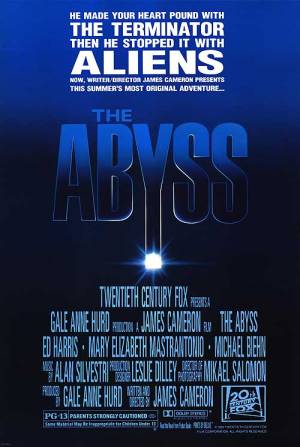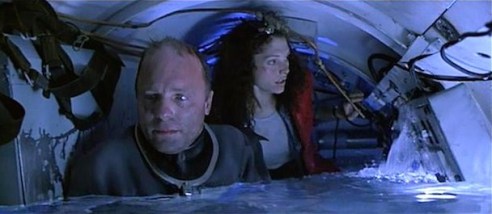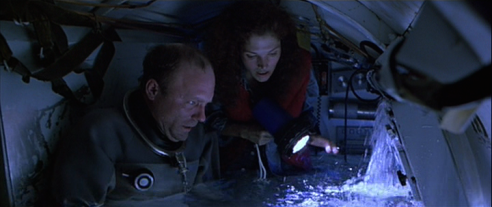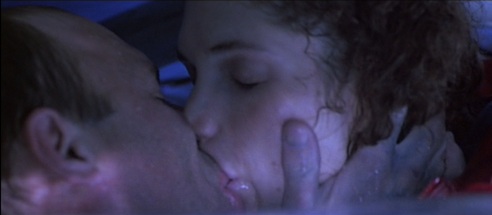Favorite Scene: The Abyss
“I’m telling you what it is, you’re just not hearing me.”
Back in 2010, two noted action directors vied for the vaunted Academy’s top award. One made “…muscular action movies, the kind with big guns, scenes, themes and camera movements as well as an occasional fist in the face, a knee to the groin.”, as Manohla Dargis once described. The other, spectacular actioners featuring sci-fi spectacles, which tugged unexpectedly at your heartstrings. James Cameron and Kathryn Bigelow.
To the surprise of more than a few, the NYT film critic Dargis was actually commenting on the latter, the woman director — Cameron being the soppy sentimentalist of the duo.
That they were once married was cited by a number of people when The Hurt Locker outdueled Avatar to win Best Picture, as well as Best Director, that year. Like other film critics and fans, it’s their former state of matrimony I’m keying on here. You see, a year later author John Kenneth Muir wrote a wonderful review for one James Cameron film in particular that elicited a comment on my part.
I’ll expand upon it in this post for it’s my favorite scene of the film, The Abyss.
[…this is your standard warning for spoilers ahead]
Synopsis
A team of undersea oil drillers and Navy SEALs attempt to salvage a crashed nuclear submarine near a deep-sea trench. Only to discover aliens living at the bottom of the ocean. A subsequent storm at the surface places the mission, and their lives, at risk. Primarily when these opposing groups argue over how to treat the Unidentified Terrestrial Intelligence (UTI) found. As hostile or friendly. The SEAL team commander eventually implements the military option by sending a timed nuke down to destroy the UTIs, which the civilian crew attempt to prevent.
Thoughts
JKM provided a splendid in-depth examination of this film. The Abyss has been a favorite of mine for quite a while, especially after James Cameron’s preferred cut appeared. Before this, the film had many great sequences, both action-wise and emotional, but lacked a really consistent and meaningful finale. This film also had some parallel with my own personal life, too.
I wed my bride in 1989, the same year The Abyss was released. Like its first-run through theaters, she and I were rough along the edges. As you’d expect from newlyweds. Married, yes. A couple we were not quite. Neither of us had had much real marital experience under our belts. The essential give-and-take skills had yet to be fully earned. Much like the theatrical cut, we weren’t very refined. Therefore, the scenes and progression of the alienated married couple in the film went right over my head.
Perhaps not my wife, but we did not see this in ’89 together, to my everlasting regret.
However, by the time the updated director’s cut arrived in ’93 for a limited re-release, now four years into marriage, man, oh man! Did the core duo of the piece, and their by-play, mean something to this wedlock vet. By now, having earned my husband stripes. It made those later scenes relevant, and wrenching beyond belief. I’ve re-watched this more than a few times over the years, most recently in June. I assure you The Abyss has lost none of its power in the time since.
The Scene
Working as a team, Lindsay (Mary Elizabeth Mastrantonio) and Virgil, aka “Bud” (Ed Harris), have used one of the rig’s submersibles, CAB One, to temporarily stop SEAL Lt. Hiram Coffey (Michael Biehn), in another submersible, from fully implementing his plan to nuke the aliens. The aftermath of their underwater mechanical scrap, Coffey and his sub are no more. But, the estranged couple is left 60-70 yards from Deep-Core and safety in their damaged vehicle. Sitting without power, leaking like a sieve, with only one aqualung suit between them.
The sequence in the flooding submersible a classic of taut action. Yet, one filled with emotion. Brimming over with ever-increasing tension only tight spaces and impending death can deliver onscreen. It’s also absolutely spot-on as an example, through dialogue and demeanor, of two people who know each other. By marriage. Fostering a unique bond through previously shared experiences, both good and bad. Forcing the pair to turn to the other, actively, looking for a way to survive…literally as a couple.
As mentioned, only being married can imbue such familiarity.
Watch the scene carefully. In clear and in small ways, each calms or tamps down their other half’s detrimental, panicky reactions to their dire situation. Each spouse pushing their significant other toward their strengths — like all good partners do. Other married people out there may see what’s worked for them in the scene. I did. Now, take it in again, it’s a short sequence, to glean why the scene, and their marriage, works.
Listen to the condensed way Mastrantonio’s character focuses Bud, and he her.
“Okay. Calm down, Bud. Calm down.”
Lindsay expresses it with that ‘mommy-voice’ that parents and children will undoubtably recognize, as the water rises. Forcing her tenor down as many women do to establish control of a situation. Particularly, one where panic or anger can get quickly out-of-hand. I’ve come to believe Cameron shorthands this brilliantly in the segment through dialogue, as well as music.
“…a minor-key variation of the main Abyss theme for this scene…which lent an elegiacal tone to it…and reinforced the emotion of the performances. Jim Cameron felt that the scene might play even more powerfully, if the music played against the emotion instead, so Silvestri recomposed it as a suspense cue, which underlined the coldness of the circumstances. This made the emotion of the performance even stronger without becoming melodramatic.” ~ as noted in the long-in-tooth DVD text commentary
The high-tech auteur writing it in such a way that emphasizes their history as a twosome, and as their only way out.
It’s the other reason I appreciate James Cameron as a filmmaker, which helps me to get beyond the well-known and aggravating ego1 of his. How he always strives to make a scene accurate and believable in a human context. Even among all the technology — some invented by him — that’s put into play. One of the best at incorporating characters’ sentiments within the machine environments he’s crafted on film.
“You’re smart, think of something. Can’t you think of something?”
Gather the specific scene elements in. All of Lindsay’s and Bud’s previous interactions, along with their failing marriage, builds toward this supremely stressing sequence. Their union and problems peaking in the midst of finally working together, with only drowning as the outcome. At a point of incredible desperation, a hopeless situation, seemingly. “This is not an option. Forget about it.” When self-preservation is not the first thing on your mind, then something else is in play.
“Shut up, and put this on!”, Bud’s (and most men’s) fallback. Typical. The louder voice wins…until it doesn’t. All the married couples reading this, raise your hands if you recognize this archetypical remedy. Thought so. It rarely works, especially in marriage. “This isn’t logical.”, Lindsay’s more mature response. “Fuck logic!” You know who says that without even watching the scene, now don’t you?
Finally forcing her to hatch the only ploy that has any possibility out of this mess:
“I go into deep hypothermia. My blood will go like ice water, my body systems will slow down…they won’t stop. You told me that. Like they can revive after ten or fifteen minutes. It’s the only way.”
Lindsay focuses Bud, whether he likes it or not, with the only chance both of them have to survive.
Cameron employed a known physical response to cold water for this. The Mammalian diving reflex. So that Bud can save her life. Counting on authentic, for the time, resuscitation techniques, thank you very much. Meaning, Lindsay’s got to force herself to do something that goes against all of her body’s instinctive, reflexive response — intake water into her lungs.
Perhaps, this was the filmmaker’s symbolism — going against an individual’s (or humankind’s?) selfish nature for a chance at something better.
In this case, immediate and in the long run, for more life. It’s a huge step demanded by and of this character. All manner of human instinct and panic will implore you not to do so. It’s a ghastly, but ultimately daring move to live, nonetheless. James Cameron very much that human optimist John Kenneth Muir says he is.
Even if it’s a clever idea, drowning, as Lindsay begins to face the prospect, is nowhere near a pleasant undertaking. And holding your breath not an alternative.
“Most people who drown actually suffocate to death. The body’s reflexes are trying to prevent water from entering the lungs, so the victim runs out of oxygen and has a buildup of carbon dioxide that isn’t exhaled. Only after death do the muscles relax and allow water to flow into the lungs. Lindsey has to intentionally inhale the water to try to freeze herself.”
Autonomic breathing can kick in, even for experienced divers, which will have you draw in a breath. What she needs to do, here. Lindsay must avoid suffocating to death. She has to drown for this to work…thereby putting herself into that thermal shocked state. The way the director filmed the sequence, Mastrantonio plays it for all she’s worth. For every last bit of air left in CAB One. Claustrophobic aquaphobia.
Virgil gets a front-row seat to watch this, too. Lindsay knows this. “You can do it, you know.” A wife granting reassurance to her husband for the hardest task he’s about to undertake, in the only way a spouse can. Giving a kiss on Bud’s helmet faceplate when a spoken word is no longer possible. Holding him as she turns her head to his side to take in the cold sea, with Cameron shooting a close-up of Bud’s face to not miss his anguish of feeling her drown. As my friend John Kenneth Muir wrote a few years back:
“In The Abyss, one harrowing scene — amongst the most harrowing ever seen in a science fiction film, actually — asks the viewer to contemplate at point blank range the prospect of drowning. “
This was as close I’d ever want to witness such a thing — sitting safely in a movie theater, or at home, watching…knowing I’m as far away from this as I could possibly be. James Cameron deftly crafted one of the most memorable, and uncomfortable, scenes imaginable. Yet, made it meaningful beyond what’s depicted. Hopefully witnessing the love of two people finding a way to keep their union going, in the most extreme and heartfelt circumstances possible. Lindsay’s earlier words always echoing the underlying attitude of it all.
“We all see what we want to see. Coffey looks and he sees Russians. He sees hate and fear. You have to look with better eyes than that. Please.”
- On the set of The Abyss for a scene where Ed Harris’ character runs out of oxygen, the director purposely gave him an empty scuba tank for a realistic asphyxiation! The story goes, after he found out what happened, the actor punched out James Cameron; they haven’t worked together since. ↩








9 Responses to “Favorite Scene: The Abyss”
Great trivia, great blow-by-blow, great film, great post, Michael! Claustrophobic aquaphobia. AAAARRRGGGGG. This scene makes me squirm.
LikeLiked by 1 person
Thank you very much, Cindy. It is indeed a great film. 🙂
LikeLike
Beautiful post! That sounds like an amazing, powerful scene. I didn’t watch the clip. I want to see that sequence in the context of the film.
LikeLiked by 1 person
Oh, yes. Check out the film, Fernando. Well worth it. Many thanks, my friend 🙂
LikeLiked by 1 person
I will!
LikeLiked by 1 person
Oh you made me want to rewatch this soon! LOVE this movie. WOW, that’s nuts what Cameron did to Ed Harris! I’d punch him too, sheesh.
LikeLiked by 1 person
Sorry to be soooooo late in replying, Ruth. Yeah, I’d have punched Cameron, too, for that stunt he pulled. Many thanks for the comment, my friend. 🙂
LikeLiked by 1 person
[…] received for their ticket buying pleasure was a cross between The Abyss (the original, not James Cameron’s director’s cut), Forbidden Planet (without the Shakespeare…or even an adorable robot), not to […]
LikeLike
[…] I went with this in the same year of Tim Burton’s Batman, even the more daring Miracle Mile, The Abyss, or Sea of Love fanship. So […]
LikeLike